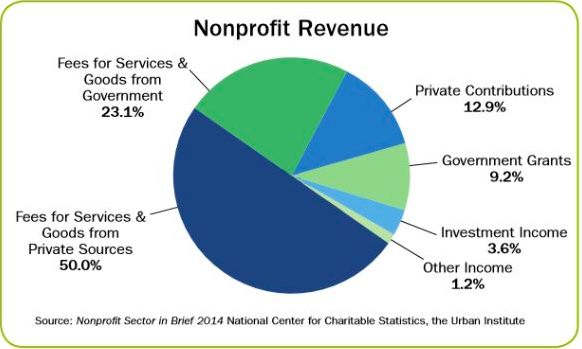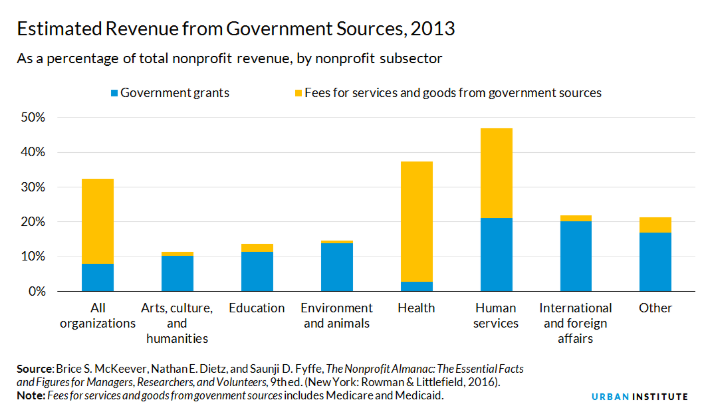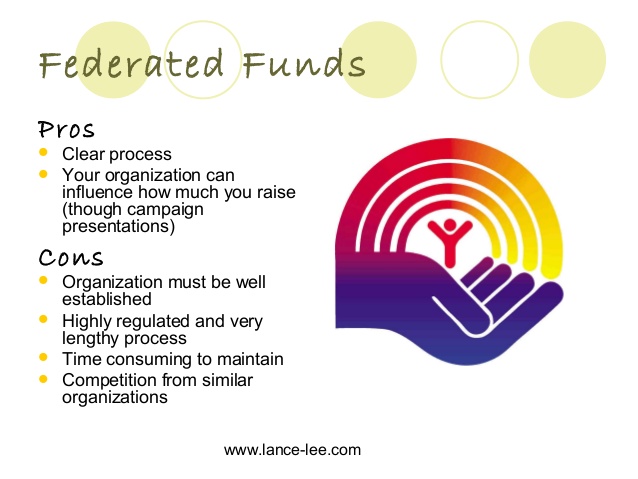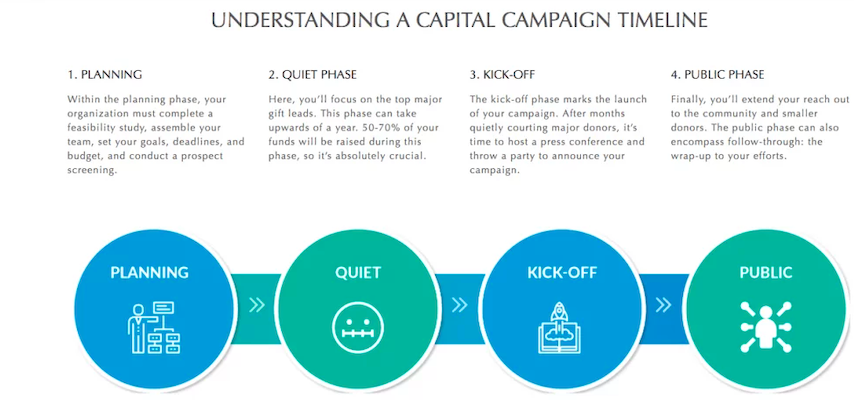Table of Contents
Nonprofit grants are a substantial way in which nonprofits generate revenue for themselves. Resource planning for a nonprofit becomes much easier when there is an expected grant on the horizon. Knowing the type of nonprofit grant you want to apply for can increase your chances of receiving one significantly.
Let’s take a look at some statistics. Way back in 2014, if I were to ask a nonprofit – “How are you funded?,” here is a rough breakdown of the various sources I could expect:

Fast forward to today and the diversification of revenue still holds. What changes is that individual giving has shot up and makes 72% of total income.
But what has remained consistent over the past five years is that contributions from Government grants and private donations still form a substantial source of revenue.
Funding from foundations makes up 17% of total revenue. And that is what I want you to focus on.
Despite being notoriously hard to win, nonprofits still resort to grants as an essential source of income. That is because it provides a crucial means of diversifying revenue. Also, having a dedicated source of income from gifts is important for an organization’s sustainability.
Read Also: Nonprofit Fundraising: The Most Comprehensive Guide
Advantages of grant funding for nonprofits
- The concept of “free money”: Funding from grants is quite attractive because, unlike a loan, you do not have to repay it. More importantly, your nonprofit need not relinquish control (in terms of equity or shares) to the organization that is making the grant.
- Visibility and credibility for nonprofits: When you receive a grant from an organization, you receive more than just money. A prestigious organization believes in your nonprofit’s mission and trusts your ability to deliver – so much so that they are happy to financially back it. Such an overt acknowledgment is a stamp of approval that helps you win donors’ trust.
- Once you get one, the rest is more accessible: It is always the toughest to get awarded the first grant. Being approved by one foundation acts as social proof – not just for your supporters, but also for other grant foundations. So, they would be much more willing to support your cause.
The catch is that getting a grant approved is really hard. On average, 2,700 grant requests are submitted every day. Less than 200 get funded.
With such fierce competition, a key to winning grants is identifying and applying for a grant that is the most suitable for your nonprofit.
That is where this post would help. It gives you a comprehensive list of the various types of grants available and also a gist of the kind of organizations that they potentially fund (or don’t).
Take a quick look at which one would suit your cause the best.
Types of nonprofit grants
There are two ways to classify grants:
- Based on the source of funds
- Based on how the funds will be used (by your nonprofit)
These two categories are not mutually exclusive. For instance, technical grants are those bestowed with the explicit intent of meeting a nonprofit’s IT requirements. Strictly speaking, this falls under the latter category.
But, technical grants can be funded either by a Foundation or a Corporation – (as they would be giving the money).
Read Also: Nonprofit grants – What is It and How to Find One for Your Nonprofit
So you can approach a corporate or a Foundation for a technical grant (so long as it is within their mission statement). Let me explain it in much more detail:
Types of nonprofit grants based on the source of funds
Where does the money come from? Does an individual give it? The Government? Or some other grant-making organization? The answer to this question is the basis for classifying this type of grant.
Based on who is gifting you the money, you can classify grants into:
Government grants
Grants funded by the Government (basically taxpayers’ money) are called Government grants. Based on the jurisdiction and the area they cover, you can further break them down as:
- Federal grants: Grants bestowed to any nonprofit across the country
- State grants: Grants that are only for nonprofits belonging to a particular state
- Local grants: Grants that are limited to a specific community or a district
The advantage of Government grants is that they can fund the operative and administrative costs for your nonprofit (something that other grants are reticent about).
Also, you can apply for more than one Government grant (as long as you meet the eligibility criteria). For instance, you can apply for a local grant and a federal grant to finance a specific project for your mission.

This graph indicates the kind of nonprofits that are mostly funded by the US Government in 2013 are typically international and foreign affairs. That is not to say that your nonprofit won’t get funded if it falls under a different category.
It just means that you should be aware of your chances of winning the grant for your organization.
As a nonprofit, the most significant benefit that comes with a Government grant is that it has ‘no strings attached. That means, once the money is bestowed, you are fit to use it for expenses as you have outlined in the grant application process.
Pro tip: Remember Government grants do not even ask for a fee for the application process. So, if you come across a fee for the application, make sure to double-check it – there is a good chance that it is a scam.
The only apparent ‘downside’ to a Government grant is that the application process is extremely stringent. Also, the competition is quite high. Often the same type of nonprofit grant is open for not just nonprofits, but also businesses and public or private universities.
One such example is the FY 2019 Cultural programming support. Listed on Grants.gov, it called for applications from Feb to June 2019. The grant welcomed American artists to Moscow to showcase their talent in music, performing arts, culinary skills, and more. As mentioned above, it was open to not just nonprofits, but also small businesses and public or private universities that could meaningfully profit from the exercise.
You might also like: Nonprofit Grant Writing Essentials And What Major Foundations Look For
Foundation grants
Foundation giving is a type of nonprofit grant that is a huge source of revenue for the nonprofit sector. In 2014, it single-handedly contributed $54 million (in the US) to various nonprofits. Across the pond, the situation is no different. Giving through charitable foundations accounts for 15% of total giving (that’s a whopping 2.5 billion pounds) in the UK.
The Rockefeller Foundation, the Carnegie Foundation, the Wellcome Trust (in the UK), and the Getty Foundation are a few examples of organizations that are philanthropically inclined. These Foundations make money either by recurring bequests or by strategically investing their assets.
Clearly, Foundation grants can be a significant source of income for your nonprofits. Here are the various kinds of foundations that you can approach with your proposal.
Family foundations
Family foundations are those whose sole source of funding comes from one family. Also, members of the funding family serve on the board of directors (or as a chairperson) and are actively involved in directing funds towards a specific cause.
The Bill and Melinda Gates Foundation is an excellent example.
Approaching a family foundation for funds has its pros and cons. On the one hand, the grant could be more comfortable to win because you can also appeal to the family member directly with your cause (their opinion can make or break the decision of supporting your nonprofit).
On the other hand, since popular foundations are besieged with numerous proposals, it would be tough to get the grant in one go.
Private foundations
Like family foundations, private foundations are also funded from a single source. The difference is that the money can come from a single person (and not necessarily a family.)
Private foundations are of two types. They could be operable and inoperable.
Operating Private Foundations are those that have their own programs. Instead of merely disbursing funds, they launch initiatives to meet their goals. An excellent example of this type of Operating Private Foundation is the Paul Getty Foundation. Funded by a petroleum giant, it has its own initiatives to keep art and history alive.
Needless to say, applying to an Operating Private Foundation for grants is not a great move. Unless they explicitly call for grant applications, they will not fund any ventures but their own.
On the other hand, In-operating Private Foundations are grant-making foundations. Their complete focus is on funding nonprofits like yours so that they can get a little bit closer to their mission.
The only catch is, that private foundation grants do not typically cover operative costs for your nonprofit (well, not always). So read the grant eligibility criteria thoroughly before applying.
Read Also: Nonprofit fundraising 101: How to ask for donations for nonprofit
Public foundation
Also called a grant-making private charity, these are organizations that get money from a variety of sources. It could be from the Government, numerous individuals, or even multiple families. As their name suggests, they ensure that the funds are given as grants to the right nonprofits to further their cause.
Community funds
A community fund raises money from a specific community, from various donors, for the improvement of people in a particular geographic area. Here is a snapshot of how the Community Foundation of Greater Fort Wayne bestowed grants in Q1 of 2018:

A community fund can allow for various types of donations to increase the number of funds at its disposal. The Community Foundation of Snohomish County is the perfect example.
For instance, it can have donor-advised funds, where the donor who is contributing funds has a big say in how the funds are used. As a nonprofit, if you want to apply for these funds, then it is vital to cultivate a good relationship with the said donor.
Community funds can also be designated funds – where the funds are appointed by the donor for a particular cause. If you are applying for this grant, then you have to be sure that the donor’s intention and your mission are on the same page. If in the future, the mission of your nonprofit changes, then you risk losing these funds.
You might also like: Crowdfunding For Nonprofits: Essential Tips And Top Platforms
Corporate grants
Google, PepsiCo, and Nestle are all big companies that give to the betterment of humanity. They allocate a certain percentage of their profits every year to be given as corporate grants to deserving nonprofits.
Here is a snapshot of the Philanthropic efforts of PepsiCo in 2018.

The way google gives is via Ad grants. That is, eligible nonprofits get $10,000 in their google ad account to run ads for their nonprofit. So they could use this money to run ads for a specific fundraiser they are running or simply rank for their most relevant keywords.
Even though it is not an overt transfer of funds, the impact these Ads can have on the nonprofit is immense. More people are learning about your cause. You are getting more supporters, gaining their trust and credibility, and thus can encourage them to be more involved with your work.
So that was a classic example of in-kind donations, where instead of cash corporates equip nonprofits to meet their goals in other ways. Another example is how Salesforce takes care of tech solutions as part of its in-kind venture.
As more and more companies become conscious of their social responsibility, they are willing to give more to humanitarian efforts.
A disadvantage with corporate funding is the stigma that is sometimes attached to the grant – depending upon how the company is perceived. So remember to vet the corporate carefully before approaching them. All the grants in the world will not make up for the loss in public favor (which will mean a reduction in individual giving to your nonprofit.)
Read Also: Why Nonprofit Accounting Matters to Fundraising
Federated funds
Federated funds are those that are raised from businesses and local company workers and then distributed to nonprofits like yours. They are nothing new to the nonprofit sector.
This method of grant-giving emerged as ‘Community Chests,’ way back in 1913. Since then, it has been a significant revenue source for nonprofits. Now, you would probably know it as “United Way” – a direct descendant of the community chest.
As the pic below describes, opting for federated funds comes with its own pros and cons. Whether you choose it or not solely depends on the nonprofit fundraising strategy you adopt.

Bestowing of Federated Funds is highly regulated and lengthy because of how the bestowing organization (like United Way), raises funds in the first place.
Federated funds are raised by enabling employees to donate directly via their workplace. Typically, these are done as salary deductions.
However, since the millennial philanthropists are more ‘hands-on,’ they prefer to give to charities directly (or serve as volunteers), rather than opt to make donations indirectly.
Also, as we saw above a lot of businesses are founding their own trusts and funds to help employees give. Both the above changes in behavior have made federated funds a bit scarce and thus tough to get bestowed.
Types of nonprofit grants based on how you are going to use the funds
Before you apply for a grant, you should always have a clear idea of how the funds are going to be utilized. Will it help you pay your employees’ salaries? Is it the seed fund for your newest capital venture?
Based on this, the type of grant you apply for can be categorized into:
Building grants or capital grants:
Grants that are particularly focussed on helping a single initiative (mainly capital projects). It can help fund the groundwork, building repairs, improvements, or any one-time capital expense for your cause.
Here is a rough timeline of a typical capital campaign:

Most of your grant seeking will happen in the “Planning” phase and the “Quiet” phase of your campaign.
When you approach a grant-making organization for capital grant funding, clearly outline how these new improvements affect your nonprofit’s efficiency in achieving its mission.
Here are a few examples of foundations that support this grant:
- Kresge Foundation Challenge grant – They support 6 specific causes: health, arts and culture, the environment, human services, education, and community development.
- Smith Family Foundation – They support one-time capital expenses for nonprofits in Greater Boston
- Kroger Co. community grants – This foundation helps new nonprofits and nonprofit agencies work to solve Hunger and poverty issues, assisting victims of natural disasters and people suffering from breast cancer. The only catch is that they fund nonprofits only in those areas/communities where their stores have a presence.
With the exception of the Kresge Foundation, both the other foundations make only ‘local’ grants. And that is the catch. As a grant fundraiser, you have to be extremely aware of which organization you can approach and whether your nonprofit falls under their jurisdiction.
Technology, IT, or Software grants
Typically tech grants are a type of nonprofit grants offered by companies (or corporate giants), to help nonprofits up their IT skills. The idea is that the better equipped you are (technologically), the more efficiency you can bring to achieving your goals.
The typical examples of Google, Mozilla, and Lyft make this list. Some of the lesser-known, but equally big corporates that help nonprofits are Twilio, Techsoup and Box.org.
The above list is by no means exhaustive. They serve as a guide to help you get started looking for the best tech grant for your nonprofit.
Capacity-building grant
Capacity-building grants are not about expanding an organization’s services, adding a new program, or renovating a building,” said Barbara Floersch, executive director of The Grantsmanship Center, in Los Angeles, Calif. “They are about strengthening an organization’s infrastructure, management, and governance.
As Barbara clearly points out, capacity-building grants are aimed at helping nonprofits to tweak their internal system. So what do these grants fund are:
- The assessment and management programs of your nonprofit’s governance systems
- Initiatives that focus on evaluating the effectiveness of your service (or your efforts)
- Strategic planning initiatives that aim to increase your impact or grow your organization
- Development initiatives to improve the staff and board of your organization
- Establishing a separate fund development program
- Succession planning or mergers or restructuring exercises for your organization
- Setting up a volunteer management system or technology upgrades
- Initiatives that focus on developing an external communication strategy
Read this list? Have you spotted the most obvious disadvantage of this grant?
This is not a grant that is suited for budding or small-term nonprofits.
Small and budding nonprofits do not have the organizational efficiency to be eligible for this grant.
It is for those organizations that are well established and are already having a considerable impact. Capacity-building nonprofit grants help take the one step further and maximize the impact that they are already bringing about.
If you are planning to apply for this grant, then the bare minimum requirement is to have a definite capacity-building framework laid out. You can also take the help of other organizations to help you out.
This strategic framework of The Community Research Center (for Colorado nonprofits) for capacity building can give you an idea of how to formulate the same for your organization.

The Oak Foundation, Meyer Foundation, and WEDC are a few examples of organizations that bestow capacity-building grants to nonprofits.
General Operational grant
This covers employment grants, administrative grants, and equipment grants. General operative grants are those that nonprofits can use to address urgent issues.
Eg. Boost salaries and benefits for their employees to invest in technology or software that will help their performance. They could also use it to tweak their fundraising efforts and strengthen infrastructure to help them be more efficient in their roles.
The most significant advantage of a general operational grant is that it comes with no strings attached! The nonprofit can use the money as it sees fit, to use it in a way that can bring maximum impact.
The downside is that not all nonprofits are eligible for a general operational grant. Like the capacity-building grant, operational grants are only bestowed to those organizations that have a proven track record of creating impact.
“Because the grantee organization will decide how to use the funds, the quality of its leadership is pivotal. Grantmakers need confidence that administrators are competent, run a tight ship, and are experts in their field. “
Barbara Floersch, Chief of Training & Curriculum, The grantsmanship center
What does this mean for you?
An understanding of the various types of grants will help you get a clearer picture of what kind of grant would work best for your nonprofit.
The key is not to be pedantic about the classification every time. For instance, it should not be about answering this question:
“If you are applying for a Google Ad Grant, does that come under Corporate Grant or an Ad grant?”
(The right answer is, both of them). That is, since Google is such a big name, you would directly name this grant as Google Ad grant and move on.
As a nonprofit grant fundraiser, this extensive understanding of grant classification should help you in two ways.
- Make you hyper-focused on which grant you want to apply for
- Give you enough context on what kind of initiatives these organizations fund
So when you are hunting for the types of nonprofit grants to apply for in a portal like Gants.Gov or Grantgopher, you would know precisely what program area and keywords to select.

Or, the next time you are looking for funds to upgrade the software for your organization, you know whom to approach for a technology grant. Or, you would realize that the in-kind donation done by Salesforce could fit the bill and contact them directly.
The above are just a few examples of how you can apply knowledge about the various types of grants to your fundraising process.
What next?
And well, that’s a start. Once you have identified the type of nonprofit grant to solicit from, discuss with your board and team your choice. Make sure you build a solid case for why you stand a good chance of winning that grant and how you plan to use the money.
This inter-organization analysis of the type of nonprofit grant proposal works in your favor because
- The board gets a clear picture of your reasoning behind applying for a particular grant. They can objectively judge how useful this grant would be for your cause.
- The board can point out reasons (or flaws – if any), in your argument which negate the need for soliciting such a grant. They could, drawing from their experience, also anticipate problems with a particular grant to solicit funds.
Look at it this way: if you cannot convince them, there is no way you can sway a grant committee.
Once you have the ‘All clear’ from your board, well – you come to the second part of the process: writing a winning grant proposal.
I will cover that in the next post. Keep watching this space. Until next time!
Related reading on raising funds
- Unable to raise funds? These fundraising challenges may be the culprit
- 52 proven nonprofit fundraising ideas to raise funds in 2019
Featured Image Source: Pixabay

